Teacher Resources
In creating these lesson plans and student portal pages geared toward high school teaching, the education team takes a student-centered approach. Our goal is to create historically and culturally relevant content to cultivate student interest in both African American poetry and the Furious Flower Poetry Archive. We believe that African American poetry is rich and vital to every high school English curriculum, as it includes multiple voices of Americans that resonate nationally and internationally. For far too long the poetry taught in high school classes has been almost exclusively white-authored. Now students desire to read poetry that speaks to issues of injustice, provides multiple perspectives, and is relevant to their own lives as well as the lives of their classmates. Acting as a mirror, connecting to African American students’ own experiences, and a window, opening students’ minds and hearts to understand those who are different from them, African American poetry adds to students’ culturally diverse reading and writing tapestry. Along with other American literature read in high school, African American poetry addresses such essential questions as, “Where do people look for truth?” “What makes poetry sing?” “How important is culture?” “How can people honor their heritage?” “Can America achieve equal rights for all people?” and “What does it mean to be American?”
The lesson plans center on one of the three themes of the Furious Flower Archive: Timeline: History, Witness, and the Struggle for Freedom in African American Poetry; Language, Music, and the Vernacular in African American Poetry; or Seeding the Future of African American Poetry. Each theme-based lesson begins with relevant background information about the poet, a video of a poet reading a poem, the printed version of the poem, and follows with four question-based topics to drive instruction. The topics follow: Reader Response, History and Culture, Craft and Structure, and Reading and Writing Connections. The reader response questions engage students’ interest by asking them to draw on their personal experiences and beliefs before moving on to questions focusing on relevant history and culture, and craft and structure. The last section, reading and writing connections, acts as the formative assessment for the lesson. Students should draw from their own personal experience as well as the themes, skills, and concepts discussed in the lesson to complete either of the two questions. Each lesson plan includes aligned reading, writing, and language Common Core Standards for English/Language Arts and the Virginia Standards of Learning as well as relevant information that can be used to enrich the lessons.
Lesson Plans
THEME:
History, Witness, and the Struggle for Freedom
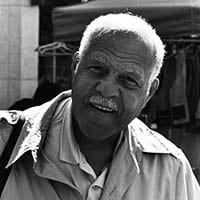
“The Apple Trees in Sussex” by Samuel W. Allen
This lesson focuses on Samuel W. Allen, who was known for merging African and African American culture in his poetry. Concepts such as colonialism and civility are referenced in this lesson. Elements of this lesson include irony, understatement, and the role of word choice in poetry.
This lesson would be appropriate for use with grades 9-12.
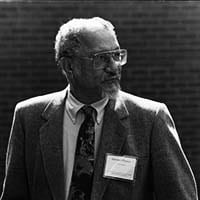
“Nat Turner in the Clearing” by Alvin Aubert
This lesson focuses on Alvin Aubert, an award-winning poet, playwright, editor, and literary critic, who was dedicated to championing African American culture. Students completing this lesson will learn about the historical relevance of Nat Turner’s Rebellion. Structural and poetic elements of this lesson focus on literary devices such as mood and extended metaphor.
This lesson would be appropriate for use with grades 9-12.
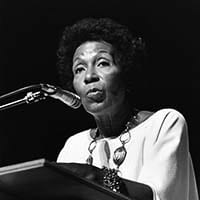
“Alabama Landscape” by Mari Evans
This lesson focuses on Mari Evans, an educator, writer, and musician, who played a major role in influencing the Black Arts Movement. References are made in this lesson to our country’s history of systematic violence against unarmed people of color. The structural and poetic elements of this lesson include imagery, personification, and perspective.
This lesson would be appropriate for use with grades 9-12.
THEME:
Language, Music, and the Vernacular

“We Real Cool” by Gwendolyn Brooks
This lesson focuses on Gwendolyn Brooks for whom the 1994 conference was named and dedicated. Students completing this lesson will use figurative language and sound devices such as rhythm, internal rhyme, jazz improvisation, alliteration, and enjambment.
This would be appropriate for use with grades 9-12.
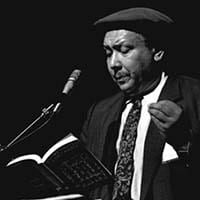
“Last Affair: Bessie’s Blues Song” by Michael S. Harper
This lesson focuses on Michael S. Harper, who was an acclaimed poet, editor, and educator, and Bessie Smith, a blues singer from the 1920s. Concepts introduced in this lesson include poetic structure, the blues tradition, and imagery.
This lesson would be appropriate for grades 9-12.
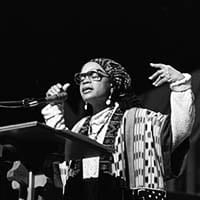
“Catch the Fire” by Sonia Sanchez
This lesson focuses on Sonia Sanchez, a poet, activist, playwright, editor, and teacher. Students completing this lesson will use figurative language and sound devices such as rhyme, rhythm, repetition, and jazz improvisation, as well as, poetic structure and rhetoric.
This lesson would be appropriate for grades 9-12.
THEME:
Seeding the Future of African American Poetry

“Blues” by Elizabeth Alexander
This lesson focuses on Elizabeth Alexander, a poet, educator, and arts activist, who was one of the younger poets to attend the 1994 conference. Big understandings, student questions, and skills are centered on cultural and personal expectations as well as poetic elements of imagery and structure.
This lesson would be appropriate for use with grades 9-12.
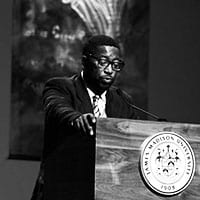
“Some Kind of Crazy” by Major Jackson
This lesson focuses on Major Jackson, who attended the 1994 conference as a member of the Dark Room Collective, and is now a renowned poet, editor, and professor. Concepts and skills covered in this lesson include the Theatre of the Absurd, community, word choice, and imagery.
This lesson would be appropriate for use with grades 9-12.

“Cousins” by Kevin Young
This lesson focuses on Kevin Young, the current poetry editor of The New Yorker. This lesson focuses on figurative language, literary devices, and skills such as allusion, repetition, and punctuation.
This lesson would be appropriate for use with grades 9-12.